 Price volatility on the global commodity markets is an accepted fact of life, but when does short-term volatility become a trend, and what are the underlying causes behind that trend? It is hard enough to analyze those effects in mainstream oil markets because of the wide separation between cost and value, but even more challenging when assessing short-term dynamics in specialty products markets, such as those for base oils and lubricants.
Price volatility on the global commodity markets is an accepted fact of life, but when does short-term volatility become a trend, and what are the underlying causes behind that trend? It is hard enough to analyze those effects in mainstream oil markets because of the wide separation between cost and value, but even more challenging when assessing short-term dynamics in specialty products markets, such as those for base oils and lubricants.
In this paper, we will address several topics:
1. The Collapse in Crude Oil and Refined Products Pricing
2. Apparent Trends in Near-term Lube Oil Consumption
3. Impacts on Base Oil Production and Profitability
4. Impacts on Margins in Lube Marketing
1. The Collapse in Crude Oil and Refined Products Pricing
While it is beyond the scope of this paper to debate the fundamental supply/demand forces which brought about the oil price collapse witnessed over the past year, when spot Brent fell from nearly $115/Bbl in late June 2014 to below $42/Bbl in late August 2015 (Figure 1), the impact on refined products markets (including specialties) has been profound.
Figure 1: Brent and WTI Crude Prices Since 2010 ($/Bbl)
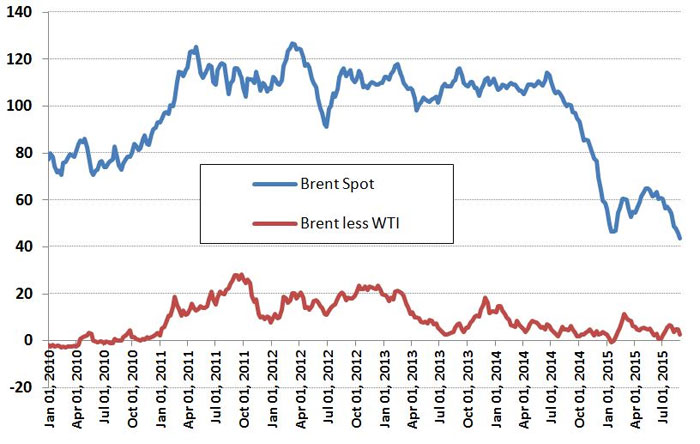
SOURCE: EIA (Energy Information Administration)
Despite the longer-term prognosis of an inevitable recovery in oil prices as the replacement cost of cheap oil increases, consumers today are enjoying the fruits of lower energy costs, which may extend for several years into the future. Conversely, oil supply indicators have been adversely affected, with rig counts down and high-cost oil supply, such as from U.S. shale plays in North Dakota and Texas, off the frenetic growth pace of recent years.
Unlike commodity mainstream oil products, whose prices are closely (and almost instantaneously) correlated with movements in crude oil prices, base oil prices are less affected by crude oil price movements, nor are these changes reflected immediately in the marketplace. While there is a limited basis risk in mainstream refined products (such as gasoline and diesel), this is not the case with base oils where considerable uncertainty exists over price formation, even if the price of crude oil is known (Figure 2). Basis risk in base oil prices has increased markedly in recent years (particularly since mid-2012) as overcapacity on world markets has exacerbated competition between producers, leading to lower margins over feed and, hence, crude oil.
Figure 2: 95% Confidence Limits on Monthly Prices of Brent Crude and European Refined Products, 2000 to 2014
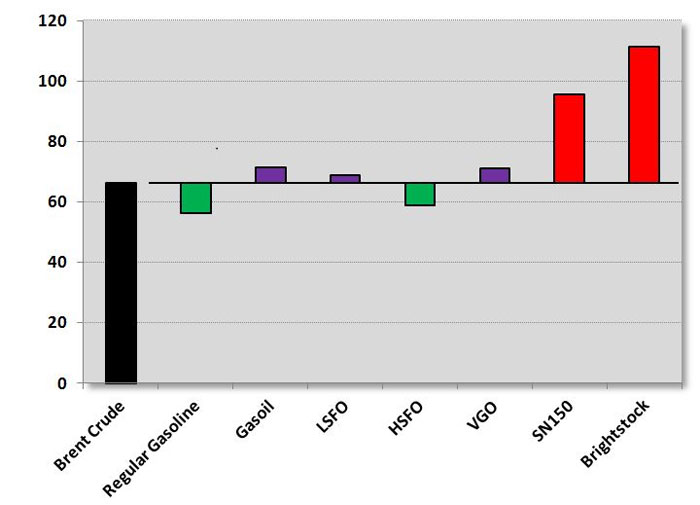
SOURCE: Kline
2. Apparent Trends in Near-term Lube Oil Consumption
Long-term trends in global lubricants markets, in Kline’s most recent assessments, indicate future consumption in the range of 40-45 million tons by 2025, depending on the scenario. However, market perturbations can create short- and medium-term deviations from these scenarios. Measuring near-term changes in lubricant and base oil consumption is complicated by the fact that there is little statistical underpinning for analyzing them. Statistical agency references to “lubricants” are, in fact, generally measures of base oil supply and demand, and thus only broadly indicative of lubricant consumption.
Figure 3: Changes in Reported Domestic “Lubricant” Consumption, First Half 2015 vs. First Half 2014 (1,000 tons)
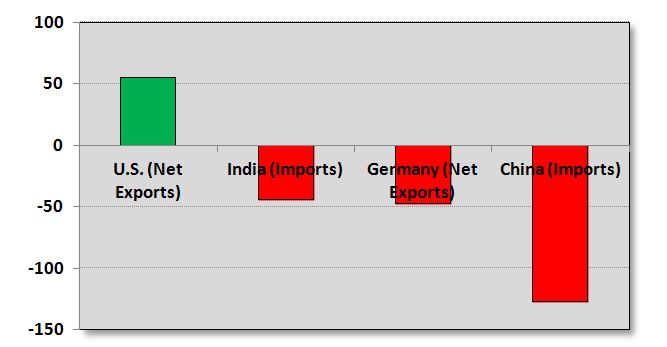
SOURCE: National Statistical Organizations
Figure 4: Changes in Reported Domestic “Lubricant” Imports and Exports, First Half 2015 vs. First Half 2014 (1,000 tons)
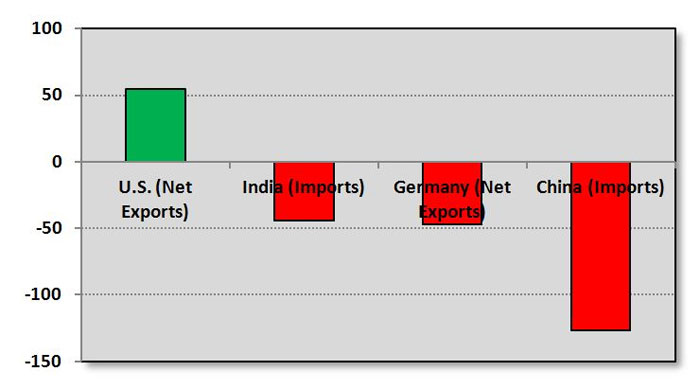
SOURCE: National Statistical Organizations
What appears to be occurring in lubricant markets in the first half of 2015 is that the engines of economic growth in Asia, particularly China, are slowing with an attendant reduction in imports (Figures 3 and 4). Conversely, U.S. consumption of “lubricants” from January through July 2015 has increased by 13% over the same period in 2014. Has this material growth in apparent U.S. consumption of base oils (and hence lubricants) been the result of economic growth, inventory build in blender and distributor stocks, enhanced exports of blended/packaged finished lubricants, or domestic lubricant demand elasticity? Not only has U.S. base oil demand for domestic blending made a remarkable leap in early 2015, but exports have increased while imports of some key base oil importing economies have fallen. While these data point to the increasing dominance of the United States as the dominant influence on global base oil and finished lubricants trade, the question of “where is all this U.S. export material going?” must await a more considered assessment when the complete picture of 2015’s market developments is available.
3. Impacts on Base Oil Production and Profitability
After rebounding from the global economic crisis, which most profoundly affected base oil demand and plant profitability in 2009, margins recovered strongly in 2010 and 2011, prompting a rash of new Group II and Group III project announcements most, but not all, of which have by now come on stream. As this new tranche of capacity hit the market and aggregate capacity utilization started to fall, competition amongst base suppliers intensified. The first effects of this capacity overhang were felt in mid-2012, and continue to this day, with cash margins in 2014 and 2015 at levels not seen since 2009 (Figure 5).
Figure 5: Annual Direct Cash Margins on Group II Base Stock Production on the U.S. Gulf Coast, 2005 to 2015
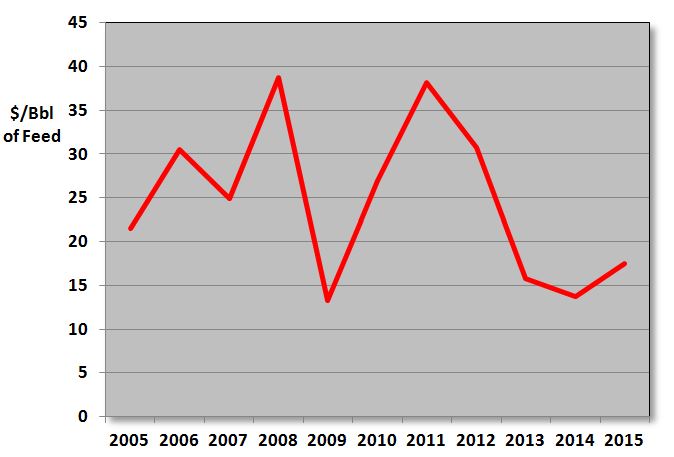
SOURCE: Kline
As noted by Kline in our recent observations on global base oil markets, Group II production on the U.S. Gulf Coast is now the critical influence on base oil price formation worldwide. This is due to the large aggregation of export-oriented capacity in the region, as well as its lower unit operating costs. As shown in Figure 6, exports of low-viscosity Group II oils have been established at around variable cost break-even values since the base oil price collapse of mid-2012.
Figure 6: U.S. Gulf Coast Export N100 Variable Cost Margin over VGO ($/Bbl of Base Oil)
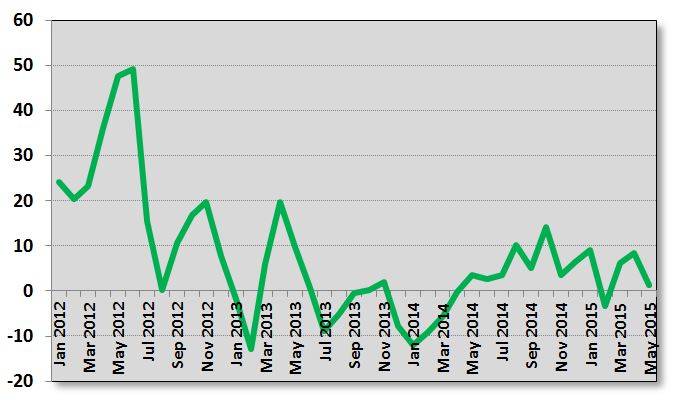
SOURCE: Argus, Kline
What will need to happen to lift the base oil industry off this floor of break-even supply economics? Demand growth in finished lubricants, if it can be sustained with the lower cost of materials to lubricants users, will help materially. Barring demand growth, and with some new base oil capacity still in the works, shutdowns of under-performing assets are the only other solution. While Group I plants, which have been the focus of closures to-date, are the obvious primary target, even Group II production cannot be considered to be completely immune from the pressures of overcapacity and downward margin pressure.
4. Impacts on Margins in Lube Marketing
One of the benefits of an integrated presence in the supply and marketing of both base oils and finished lubes is the natural hedge existing between them. Since base oil pricing is more volatile than in finished lubes, an integrated presence along the lubricant value chain act to dampen price risk. However, like all hedging strategies, integration must always be subject to the “make or buy” question. BP, Valvoline, and Fuchs have all concluded that, with a structurally long market in base oils likely to persist for several years, base oil asset ownership is neither strategically vital nor profitable.
As the price of oil has dropped since mid-2014, margins in the downstream finished lubricants market have improved, as marketers have been able to hang onto some proportion of their reduction in COGS. Though very few lube oil marketers publish earnings reports, the inverse correlation between marketing margins and raw material costs can be seen in Figure 7, which charts the changes in Valvoline’s per-gallon COGS from quarter to quarter against changes in gross margins.
Figure 7: Quarterly Changes in Valvoline's Unit COGS vs. Quarterly Changes in Unit Gross Margin ($/Gallon)

SOURCE: Kline
Given the fact that Brent crude oil prices appear to have bottomed out in mid $40's per barrel in the past two months and further significant price drops are unlikely, lubricant marketers are probably at the zenith of their capacity to make hay while the sun shines. The influx of capital into U.S. independent marketer and distributor acquisitions has been driven by the growth in downstream lubricant earnings, but it is highly questionable if this recent trend can be sustained in the face of stable or potentially increasing oil prices.

